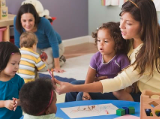Preschool classrooms should be places of joy, discovery, and safety. However, young children can sometimes feel overwhelmed by new experiences, group settings, or transitions throughout the day. When educators create a calm and nurturing environment, it helps children feel more secure and open to learning.
One effective way to reduce stress is through predictable routines. When children know what to expect, they feel more in control. Teachers can use visual schedules, sing transition songs, or offer gentle reminders before changes in activity. These small practices build a sense of stability.
Creating cozy, quiet spaces within the classroom can also help. A soft corner with pillows, books, or sensory toys gives children a chance to take a break and regroup when they feel overstimulated. These safe zones promote emotional regulation without punishment or isolation.
Positive relationships are key. When teachers respond to children’s needs with patience and empathy, children feel valued and understood. Encouraging kind interactions between peers also fosters a classroom culture where everyone feels respected and supported.
Mindfulness activities, like simple breathing exercises or calm-down jars, offer young learners tools to manage big feelings. Integrating these moments into the daily routine makes stress-reduction a natural part of the day.
Finally, open communication with families ensures consistency between home and school. Sharing strategies and observations helps children receive the support they need in every setting.
By creating a thoughtful, responsive classroom environment, educators can reduce stress and support the healthy development of every child in their care.


